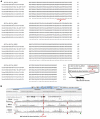Integrating Wheat Nucleolus Structure and Function: Variation in the Wheat Ribosomal RNA and Protein Genes
- PMID: 35003148
- PMCID: PMC8739226
- DOI: 10.3389/fpls.2021.686586
Integrating Wheat Nucleolus Structure and Function: Variation in the Wheat Ribosomal RNA and Protein Genes
Abstract
We review the coordinated production and integration of the RNA (ribosomal RNA, rRNA) and protein (ribosomal protein, RP) components of wheat cytoplasmic ribosomes in response to changes in genetic constitution, biotic and abiotic stresses. The components examined are highly conserved and identified with reference to model systems such as human, Arabidopsis, and rice, but have sufficient levels of differences in their DNA and amino acid sequences to form fingerprints or gene haplotypes that provide new markers to associate with phenotype variation. Specifically, it is argued that populations of ribosomes within a cell can comprise distinct complements of rRNA and RPs to form units with unique functionalities. The unique functionalities of ribosome populations within a cell can become central in situations of stress where they may preferentially translate mRNAs coding for proteins better suited to contributing to survival of the cell. In model systems where this concept has been developed, the engagement of initiation factors and elongation factors to account for variation in the translation machinery of the cell in response to stresses provided the precedents. The polyploid nature of wheat adds extra variation at each step of the synthesis and assembly of the rRNAs and RPs which can, as a result, potentially enhance its response to changing environments and disease threats.
Keywords: associated phenotypes; nucleolar dominance; rRNA structure; ribosomal protein (RP); sequence variation.
Copyright © 2021 Appels, Wang and Islam.
Conflict of interest statement
The authors declare that the research was conducted in the absence of any commercial or financial relationships that could be construed as a potential conflict of interest.
Figures









Similar articles
-
Expression changes of ribosomal proteins in phosphate- and iron-deficient Arabidopsis roots predict stress-specific alterations in ribosome composition.BMC Genomics. 2013 Nov 13;14:783. doi: 10.1186/1471-2164-14-783. BMC Genomics. 2013. PMID: 24225185 Free PMC article.
-
Differential transcript accumulation and subcellular localization of Arabidopsis ribosomal proteins.Plant Sci. 2014 Jun;223:134-45. doi: 10.1016/j.plantsci.2014.03.011. Epub 2014 Mar 20. Plant Sci. 2014. PMID: 24767123
-
Differential Participation of Plant Ribosomal Proteins from the Small Ribosomal Subunit in Protein Translation under Stress.Biomolecules. 2023 Jul 21;13(7):1160. doi: 10.3390/biom13071160. Biomolecules. 2023. PMID: 37509195 Free PMC article.
-
Promising Assays for Examining a Putative Role of Ribosomal Heterogeneity in COVID-19 Susceptibility and Severity.Life (Basel). 2022 Jan 28;12(2):203. doi: 10.3390/life12020203. Life (Basel). 2022. PMID: 35207490 Free PMC article. Review.
-
Ribosome biogenesis surveillance: probing the ribosomal protein-Mdm2-p53 pathway.Oncogene. 2010 Jul 29;29(30):4253-60. doi: 10.1038/onc.2010.189. Epub 2010 May 24. Oncogene. 2010. PMID: 20498634 Review.
Cited by
-
Remodelled ribosomal populations synthesize a specific proteome in proliferating plant tissue during cold.Philos Trans R Soc Lond B Biol Sci. 2025 Mar 6;380(1921):20230384. doi: 10.1098/rstb.2023.0384. Epub 2025 Mar 6. Philos Trans R Soc Lond B Biol Sci. 2025. PMID: 40045790 Free PMC article.
-
Personal Perspectives on Plant Ribosomal RNA Genes Research: From Precursor-rRNA to Molecular Evolution.Front Plant Sci. 2021 Dec 21;12:797348. doi: 10.3389/fpls.2021.797348. eCollection 2021. Front Plant Sci. 2021. PMID: 34992624 Free PMC article. Review.
-
Dynamics of ribosome composition and ribosomal protein phosphorylation in immune signaling in Arabidopsis thaliana.Nucleic Acids Res. 2023 Nov 27;51(21):11876-11892. doi: 10.1093/nar/gkad827. Nucleic Acids Res. 2023. PMID: 37823590 Free PMC article.
-
The Ribosomal DNA Loci of the Ancient Monocot Pistia stratiotes L. (Araceae) Contain Different Variants of the 35S and 5S Ribosomal RNA Gene Units.Front Plant Sci. 2022 Mar 3;13:819750. doi: 10.3389/fpls.2022.819750. eCollection 2022. Front Plant Sci. 2022. PMID: 35310643 Free PMC article.
References
-
- Appels R., Dvorak J. (1982). The wheat ribosomal DNA spacer region: its structure and variation in populations and among species. Theor. Appl. Genet. 63 337–348. - PubMed
Publication types
LinkOut - more resources
Full Text Sources

